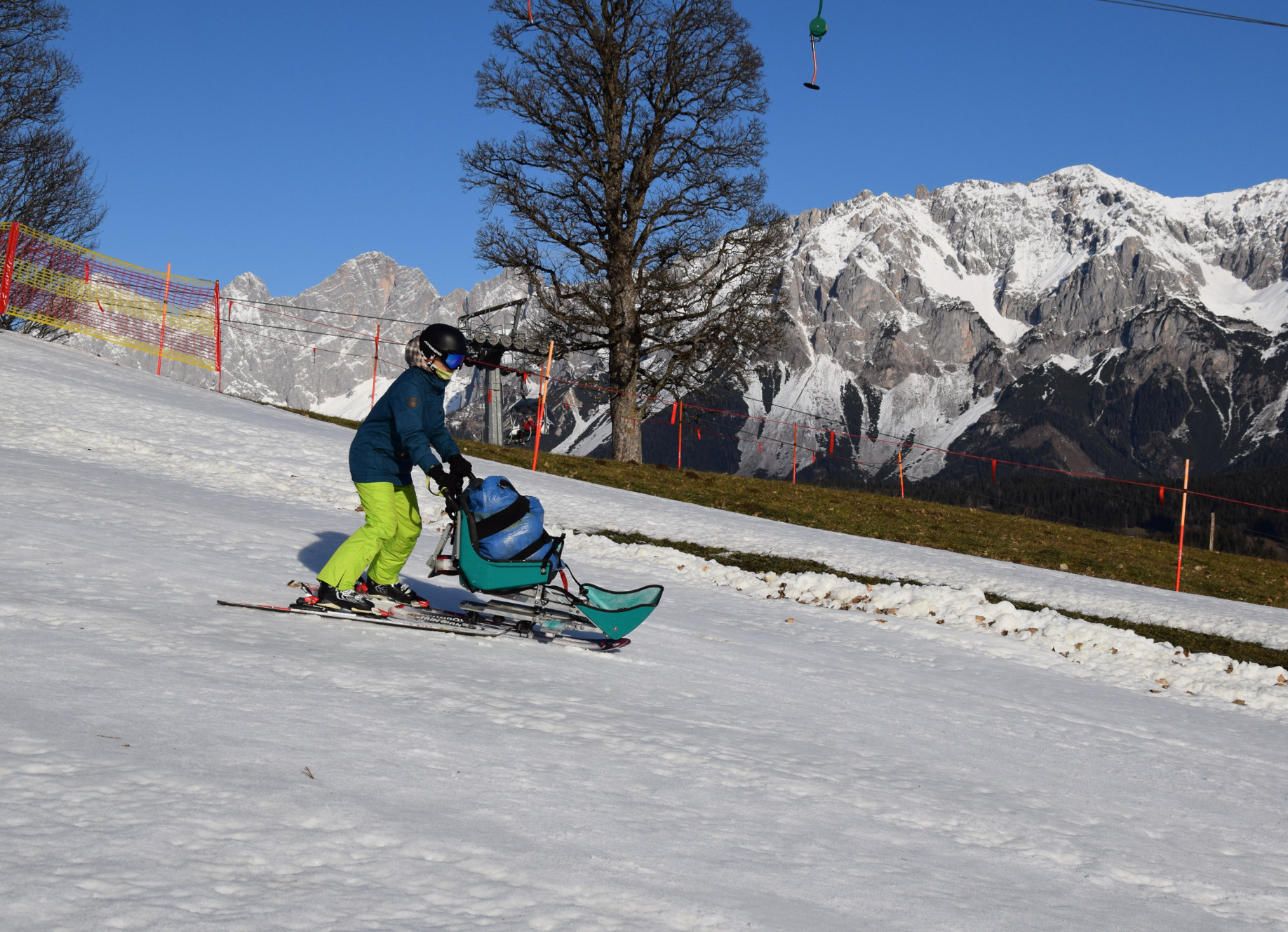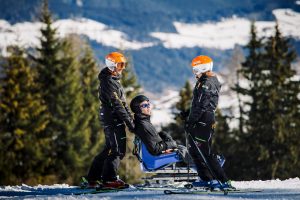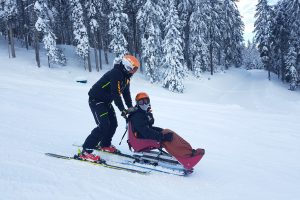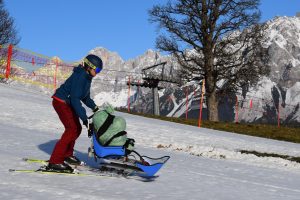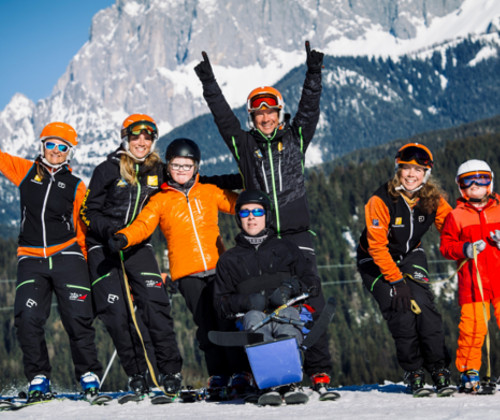Training as a “Ski instructor for people with disabilities”
from 10. – 17.12.2024
This advanced training is offered by the Styrian Ski Instructors Association and is divided into 2 disciplines:
- Bi-Ski (Bucket-Assist, Bi-Ski with fixed rigger, Bi-Ski with outrigger)
- Skiing standing up (learning disabilities, hemiplegia, stroke, multiple sclerosis, etc.)
After the 8-day course you will be able to safely teach people with disabilities in the appropriate disciplines from beginners to advanced skiers. We train our own skills and intensively deal with disability-specific safety aspects.
Suitable for whom?
The course is aimed at people who have completed a ski instructor training or comparable course. It is also interesting for regular ski schools that want to expand their range of offers and enable people with different disabilities to ski.
“Ski instructor for people with disabilities” | Bi-Ski & Standing Skiing
Date: 10. – 17. December 2024
Course fee: € 955,00
Registration: Please send an email to: info@skilehrerverbandsteiermark.at
In order to fix the training place, please transfer the course costs to Steirische Skilehrerverband, Steiermärkische Sparkassen AG, IBAN: AT04 2081 5000 2481 8775, BIC: STSPAT2GXXX
Lift costs: approx. € 150.00 – 190,00 (cash on site)
If you have any questions please send an email to info@skilehrerverbandsteiermark.at or call +43 (0) 3686 / 2119-15. Office hours: Mon-Thu 8.30 – 16 o’clock, Fri 8.30 – 13 o’clock
Accommodation: please organize your own, leisure PSO can help you find cheap accommodation: info@freizeit-pso.com
Questions: If you have any further questions about the course content and schedule, please contact Freizeit-PSO directly: info@freizeit-pso.com, +43 (0) 650 / 901 62 94. If you have questions about registration, payment etc., please contact the Styrian Ski Instructors’ Association: info@skilehrerverbandsteiermark.at, +43 (0) 3686 / 2119-15
“Ski instructor for people with disabilities” | Bi-Ski & Standing Skiing
Duration: 10. – 17. December 2024, 8 days (practical and theoretical units: 7 days, commissional practical and theoretical examination: 1 day),
Targets of the course:
- To learn the 2 disciplines Bi-Ski and its 3 sub-disciplines Bucket-Assist, Bi-Ski with crutch ski, Bi-Ski with fixed outriggers and standing skiing safely (to be able to ski on your own).
- to safely supervise and teach disabled persons in the 2 disciplines Bi-Ski and its 3 sub-disciplines Bucket-Assist, Bi-Ski with crutch ski, Bi-Ski with fixed outrigger and standing skiing
- Lesson level up to dynamic short and long radii on red slopes
- Good basic theoretical knowledge of the respective disabilities and their safety aspects when skiing
After successfully completing your training, you are entitled to teach people with disabilities in the respective discipline. Ski schools with appropriately qualified ski instructors can buy special equipment themselves or borrow it from leisure PSOs and similar organisations and thus offer their own ski courses for people with disabilities.
Course times: Planned daily course duration is from 8 am – approx. 6 pm or 7 pm.
Course location practice: Rohrmoos, course location theory: Hotel Schwaigerhof – Rohrmoos
Meeting place: Tuesday, 10.12.2024 at 8 am, Hotel Schwaigerhof – Rohrmoos
Course direction: Andras Simon, Sabine Zach & Armin Wagenhofer
To bring:
- Confirmation of a ski instructor training course or similar if it has not been completed at the Styria Ski Instructors Association
- complete ski equipment, ski length approx. 140 – 160 cm, helmet (compulsory)
- Learning materials are handed out on the first day of the course
General:
- Minimum requirement: completed ski candidate, children’s ski instructor or similar course (e.g. university, club training, other)
- Cancellation: If something should come in between, please cancel in time. Without cancellation the course costs will be charged in full. We recommend that you take out cancellation insurance.
- Each discipline will be tested and certified individually.
Standing Skiing
Skiing is possible for everyone, e.g. people with trisomy 21, autism, ADD and other learning disabilities! Even people with different physical disabilities can ski standing up. For example, people with a stroke, a hemiplegia, multiple sclerosis, etc.. With special aids, it is possible to automate certain movements, such as braking, and thus build up muscle memory. This means that the student does not need to be able to follow clear instructions. Fun and safety are always at the forefront, so learning goes without saying!
During this part of the course we will learn a lot about the individual disabilities and their particularities when skiing. The practical part teaches the safe use of special equipment and numerous aids. Equipped with such theoretical and practical knowledge, it will be easy to put what you have learned into practice. Standing skiing is also an ideal discipline to offer appropriate ski lessons as a regular ski school with the simplest possibilities.
Bi-Ski – general
People with various disabilities can ski a Bi-Ski. It is suitable, for example, for people with spastic paralysis, hemiplegia and craniocerebral trauma! Even people with severe physical and mental disabilities can practice the popular sport with this ski with more or less the support of a ski instructor. With the highly developed technology of the different Bi-Skis nothing stands in the way of disabled skiing.
Throughout the course, a great deal will be learned about the respective handicaps and peculiarities related to skiing. Bi-Ski is one of the most varied types of sitting skiing. The different models and their advantages will be introduced and discussed in detail. Another important part of the course is the extensive practice in all 3 sub-disciplines of Bi-Skiing. Thus all participants gain a lot of routine and security as well as handicapped specific knowledge until the end of the course and can thus carry out an individual lesson.
Bi-Ski – Bucket Assist
In order to introduce people with disabilities to bi-skiing, the sub-discipline Bucket-Assist is usually chosen. In this variation of bi-skiing, the ski instructor drives directly behind the seat ski, holds the bi-ski in place and steers it directly. The student can support the steering process by leaning with the ski. Some people can only ski in this discipline because of their disability.
During the course this method is learned safely.
Bi-Ski with fixed outriggers
Persons who are not able to hold crutch skis with their hands due to their handicap have the possibility to ski with so-called fixed outriggers. The ski can be controlled, for example, by shifting its weight. The ski instructor is connected to the seat ski by lines and can thus assist the student in steering and braking.
This method is learned safely during the course.
Bi-Ski with crutch ski
People who can hold crutch skis with their hands can use them to control the Bi-Ski. The ski instructor is connected to the seat ski by lines and can thus assist the student in steering and braking.
This discipline is learned safely during the course.
Further offers

Adaptive ski-school for people with disabilities

Equipment rental

Helpertraining














